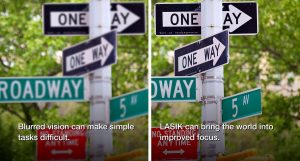
Individuals who want to improve their vision and reduce or eliminate their dependence on prescription lenses should consider LASIK. LASIK reshapes the cornea to correct imperfections that cause nearsightedness, farsightedness, and astigmatism. Dr. Andrew E. Holzman prepares his patients in Washington, DC, Maryland, and Virginia, for what to expect before and after LASIK treatment.
Before LASIK Treatment
Most people who consider LASIK do so because they can’t complete basic tasks without some type of prescription lens, and they are tired of the inconvenience of glasses or contacts. Fortunately, LASIK can correct nearly all forms of vision impairment, so most people are ideal candidates for the procedure. Of course, before proceeding with treatment, Dr. Holzman needs to perform a thorough evaluation to be sure.
Before LASIK patients undergo a comprehensive eye exam. The eyes are dilated and we evaluate overall eye health, the type and degree of vision impairment, and the thickness of the cornea. If the exam determines that a patient is a good candidate for LASIK, we use advanced software to create a digital map of the eye. This map identifies irregularities that cause vision impairment, and allows us to personalize a LASIK treatment plan that addresses these errors.
The LASIK Procedure
The LASIK procedure itself is fast and painless. To start, the eyes are numbed with medicated eye drops so that the patient feels completely comfortable. Dr. Holzman then uses a high powered laser to change the surface of the cornea and eliminate refractive errors. To gain access to the corneal tissues, he creates a small flap along the top of the cornea. The flap is lifted, corrections are made, and the corneal flap is lowered back down so that the tissues can heal. The entire procedure takes roughly 10 minutes per eye.
After LASIK Treatment
When LASIK is complete, patients will have a brief recovery period at our office. After resting, patients will need a friend or family member to drive them home. The eyes will be sensitive following LASIK treatment, so we provide patients with eye shields or dark lenses to wear.
People can expect to feel especially tired following LASIK. We advise patients to take a long nap upon returning home from their LASIK procedure. The eyes will continue to be sensitive for several days, so it is important to avoid bright sources of light (such as televisions or phone screens) and to wear dark lenses whenever outdoors. Other common side effects during LASIK recovery include dry, itchy eyes and general eye irritation.
Many people notice an immediate improvement in their vision following LASIK, but it can take several weeks for the vision to stabilize and for the full effects of treatment to be realized. Patients must attend a follow-up appointment the day after LASIK for an eye and vision exam. At this appointment, most patients’ vision has improved to the point that they are given permission to resume driving. Once LASIK recovery is complete, over 90 percent of patients enjoy 20/20 vision or better.
Contact Dr. Andrew E. Holzman
If you are considering LASIK treatment and would like to learn more about what to expect leading up to or following the procedure, Dr. Andrew E. Holzman can answer any questions you may have. Contact us online at your earliest convenience, or call (703) 420-7097 to schedule a personal consultation.



